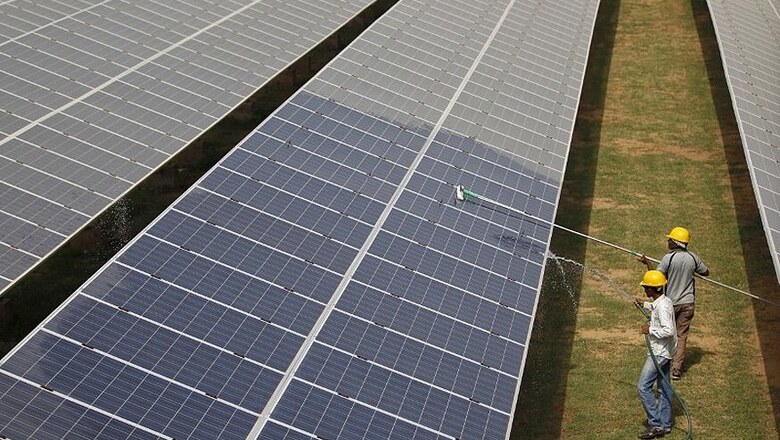
views
Prime Minister Narendra Modi’s aggressive push for ‘Make in India’ to bolster domestic manufacturing and make its economy ‘self-reliant’ in the post-pandemic era is a welcome opportunity for India’s solar energy sector. Supply disruptions from China due to coronavirus outbreak and subsequent shortage of solar components and modules have impacted India’s ambitious energy target of achieving 100 GW of solar capacity by 2022.
However, despite making significant progress in solar power generation since 2014 and emerging as world’s third largest solar market, India’s domestic solar equipment manufacturing industry has not been able to capitalise on the opportunity. India imports 80 percent of components from China required for its solar energy production. This raises an important question: does India have the core competence, capital and capacity required to offer domestic manufacturing of solar at a scale that could substitute for its massive imports?
India is energy deficient. According to World Bank, 200 million people in India still lack access to electricity. India’s energy consumption is set to grow 4.2% a year by 2035 -faster among all major economies. Its share of global energy demand is expected to double- from 5% in 2016 to 11% -by 2040. As the dependence on non-fossil fuel sources such as coal and oil is projected to decrease significantly by 2030, low-carbon sources, led by solar photovoltaics (PV) is expected to meet more than half of the new increased energy demand. Moreover, India under its climate action commitment, has pledged to generate 40% of its power from non-fossil sources by 2030. Yet, while India’s annual demand for solar cell manufacturing is 20 GW, its current average annual capacity is just 3 GW. Therefore, any further delay in domestic solar manufacturing and production will have severe ramifications for the country’s energy security and economy.
There is an urgent need therefore, for India to devise a policy framework aimed at creating a diversified domestic manufacturing industry for solar module as well as ancillary products, that could significantly reduce its import dependence, ensure a self-sufficient, sustainable and affordable energy access and generate greater employment opportunities.
India was one of the largest exporter of the best-in-class modules until 2011, with domestic manufacturers, including Bhel, Tata Solar, Moser Baer, Indosolar and Lanco, pioneering the industry. However, the lack of a consistent government policy and finance support to match the scale, quality and low price of Chinese imports, have undercut the growth of India’s solar technology and manufacturing. An aggressive strategy for long-term development of the industry in line with National Solar Mission that addresses price competitiveness, profitability, feasible finance and capacity gaps is an immediate imperative. A sustainable domestic manufacturing industry can save USD 42 billion in equipment imports by 2030, provide equipment supply security, and create 50,000 direct and 125,000 indirect jobs in the next 5 years.
Solar cell manufacturing process is technology and capital intensive. In the value chain of solar PV manufacturing that involves polysilicon, wafer, cell and module assembly, most Indian companies are engaged in later processes of module assembly. India’s has no technological expertise in capital intensive processes of silicon and ingot production. With 246 patents, India’s competence in solar technologies remains critically low as compared to leading solar manufacturing country China with 39,784 patents. There are incremental changes in technology at frequent intervals in the process of manufacturing, that require capital and know-how to absorb. As the cost of acquiring technology is high, India must incentivise and step up its own research and development of cost effective, indigenous, next-generation solar panel manufacturing technology.
As the process of manufacturing demands a multi-tiered work force with specialised skill sets such as design and manufacturing engineers, building system specialists, modelers, and assembly line workers, analysing skill gaps at each level of the value chain and devising focused capacity building measures will be a key step. While MNRE’s National Institute of Solar Energy (NISE) is engaged in R&D, testing, certification and skill development, it remains focused on solar energy generation. Joint collaboration between NISE and leading technical education institutions such as IITs, ITI, Council of Indian Scientific Research, National Skill Development Council could help develop skill development programmes particularly focused at building India’s solar manufacturing capacity.
However, any attempt to setting up solar manufacturing facilities would entail high upfront costs. In India a major financial disadvantage for setting up of industries is the high rate of interest. The cost of debt in India is 11% or highest in the Asia-Pacific region, compared to 5% in China. Setting up a specialized financing institution on the lines of IREDA that can invest in equity or debt of domestic solar manufacturing companies and support guarantees for debt taken from other financial institutions will open up new sources of financing for the manufacturing industry.
Atmanirbhar Bharat Abhiyaan has certainly opened up a huge opportunity for India’s solar ambition. However, it is also time for the government to implement the urgently-required reforms on ground!
The article first appeared in ORF.




















Comments
0 comment